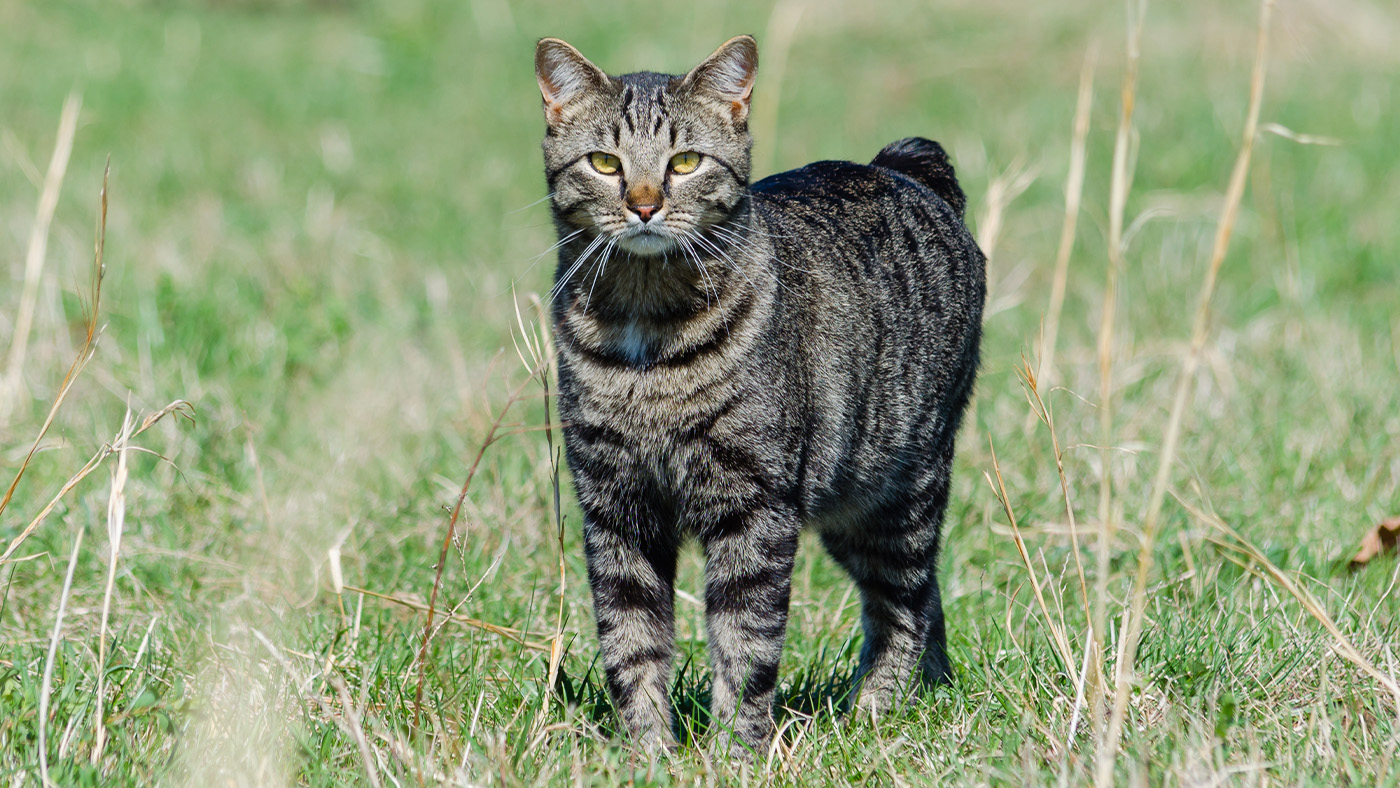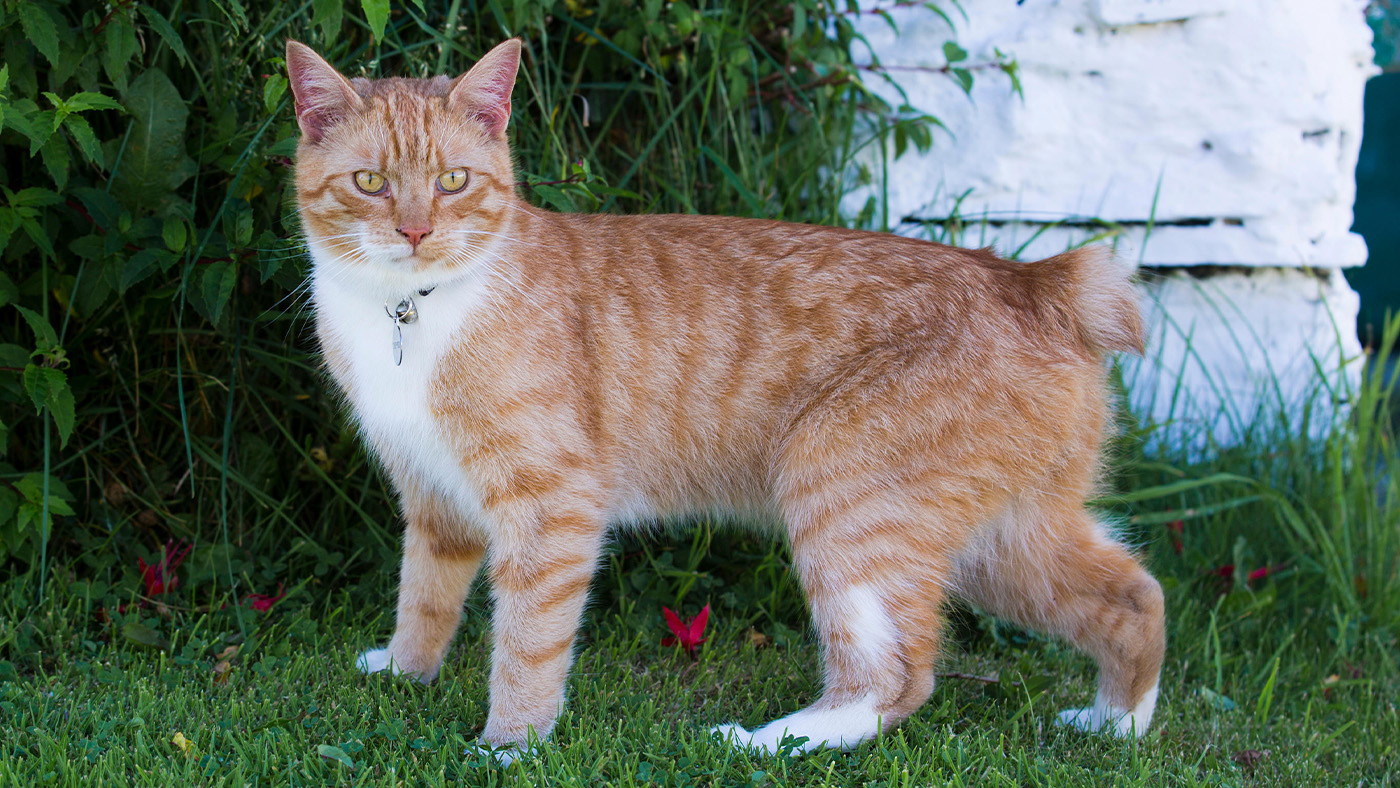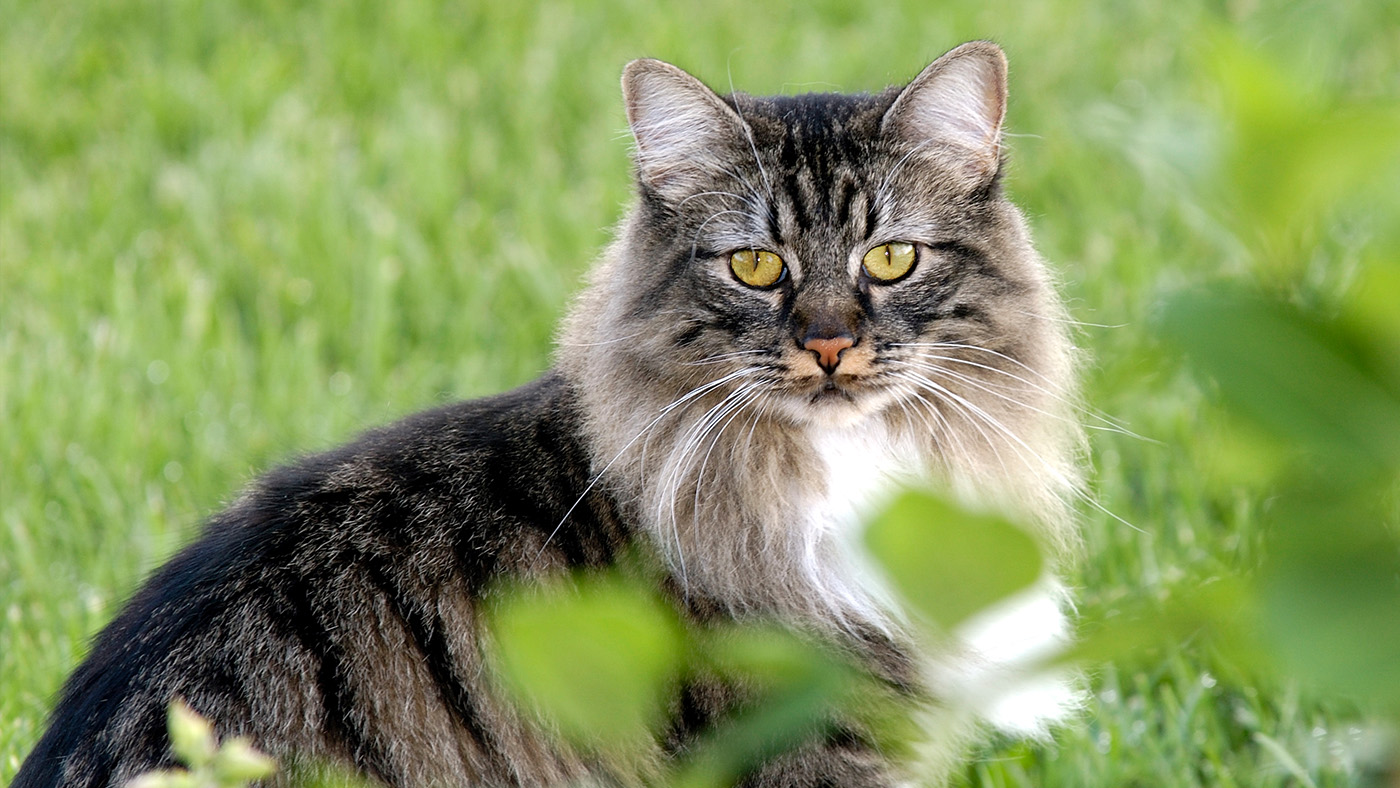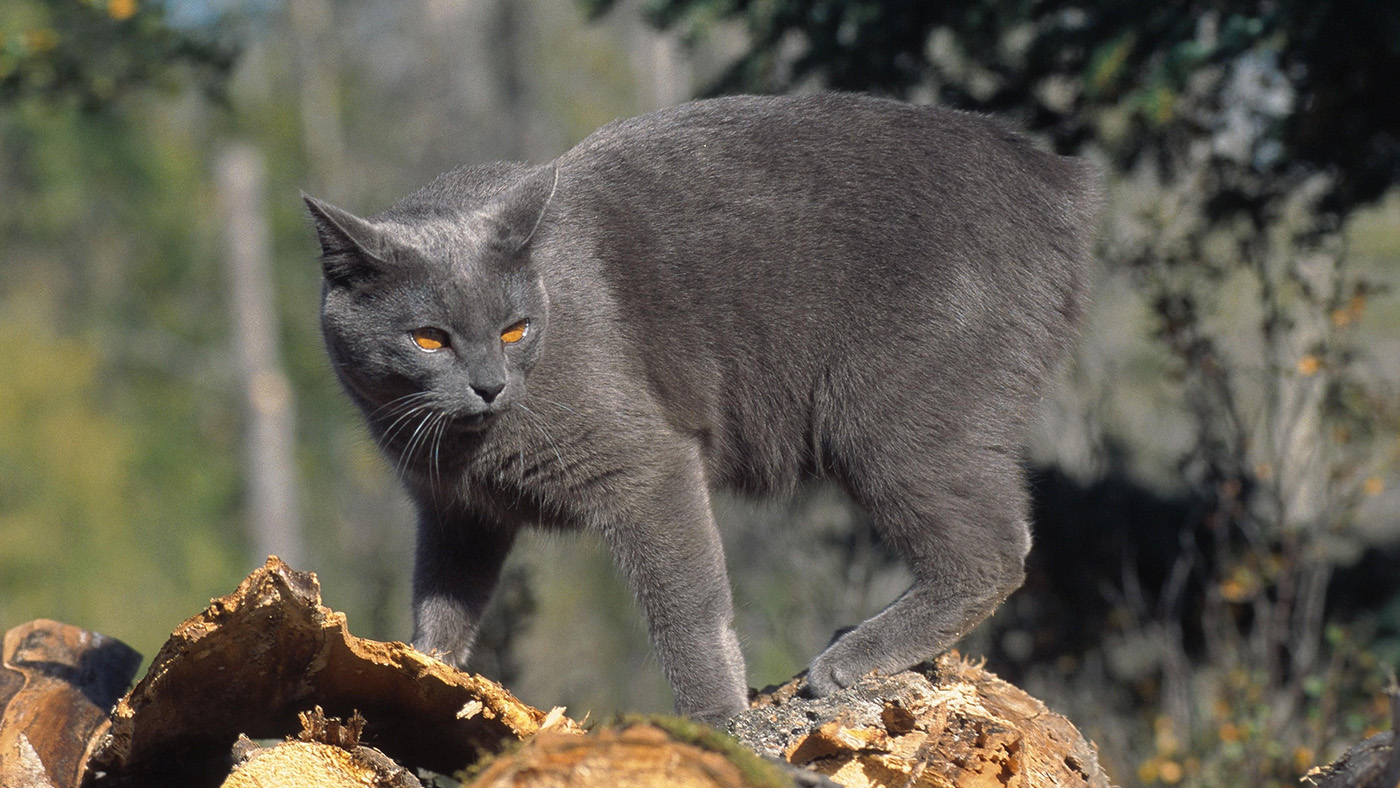Known for their ‘missing’ tail, the Manx cat is a sweet-natured feline who'll get on well with everyone
The Manx cat’s shorter tail is due to a genetic abnormality and this can cause some health issues


Other names: Manks, Rumpy, Stubbin
Life expectancy: 14–16 years
Size: 8–12 lbs and 14–16 inches in length
Coat: Short hair and long hair cat with tortoiseshell, tabby and bicolor markings. Comes in white, blue, cream, brown, black and red coloring.
Eye colour: gold, copper, green, hazel, blue, or two different colored eyes
Temperament: placid, sweet and smart
Origin/native country: Isle of Man
Perhaps the most distinguishing feature of a Manx cat is their ‘missing’ tail, which is the result of a natural genetic mutation that shortens it or leaves them with no tail at all. But the gentle and easygoing Manx also has many other attributes to its name, including its sweet and unassuming disposition, its strong independent streak and love for the great outdoors.
Believed to have originated from the Isle of Man, the Manx cat is one of the oldest natural cat breeds and is most closely related to the British Shorthair and Norwegian Forest Cat.
Keen to find out more about a Manx and discover whether this feline friend could be right for your home? To help, we spoke to vet Dr Rebecca MacMillan to find out more about this highly sociable and friendly breed.
Are Manx cats born without tails?
Manx cats are born with either a much shorter tail than normal or, in some cases, no tail at all.
“It is actually a genetic abnormality that causes them to have this characteristic breed defect,” Dr MacMillan explains. “However, the genetics that control tail formation can also make them prone to other health issues.”
Due to this genetic mutation, Manx cats mustn't breed with other Manx cats as the gene that causes a tailless cat is dominant and needs to be paired with a recessive tail gene. This means that a Manx cat has to be bred with a cat that has a tail.
Are Manx cats hypoallergenic?
Unlike the Balinese, Javanese, Devon Rex and Cornish Rex, the Manx cat isn’t considered to be a hypoallergenic breed.
Get the best advice, tips and top tech for your beloved Pets
For starters, the Manx cat comes with a double coat, which, just like a Maine Coon, and Ragdoll, means they have an extra layer of fur. This can make them prone to shedding, especially during seasonal changes.
And secondly, this breed produces the Fel d 1 protein in their saliva, which they can spread across their coat during grooming. As the primary allergen for most people, it's this protein that can trigger your allergies.
What grooming needs does the Manx cat have?
Due to their double coat structure, the Manx cat will need grooming regularly (preferably daily) to keep your moggy mat-free.
If you have a short-haired Manx, you might find that weekly grooming your pet will help keep knots and tangles at bay while also reducing molting and those pesky fur balls.
The good news is that there are different types of cat brushes, so no matter whether you decide on a long-haired or short-haired Manx, there is a range of brushes to choose from.

How much exercise do Manx cats need?
Manx will benefit from around 30 minutes of exercise a day to help keep them happy and healthy. This can range from playing with toys, chasing automated cat toys, like a ‘running’ mouse or rolling ball, or climbing one of the best cat tree towers.
Manx cats also enjoy using puzzle toys, fetching and some may enjoy walking on a cat leash. Manx cats are also considered to be a breed that prefers to be outdoors as they love to hunt.
Therefore, if you have any rodents roaming around your garden or small trees they can climb, this independent feline will thrive spending some time in your garden.
There are a number of pros and cons to having an outdoor cat. For starters, outdoor cats will have more opportunities to exercise. Exploring nature can also help banish boredom.
However, it does mean there are. more risks for cats who love being out in the open. For example, letting your cat roam free can mean that they may wander too far and be unable to find their way home. They may also pick up a disease, which can be spread via fleas.
Of course, there are a number of ways to minimize this risk without cutting your cat off from the outside world, like investing in one of the best pet trackers or the best flea treatment for cats. But either way, if you are thinking of adopting a Manx, it's worth keeping these points in mind.
What is Manx cat syndrome?
There are a few health conditions that can affect Manx cats. But perhaps the most common is 'Manx syndrome', which can affect Manx kittens and usually the ones born with no tail at all.
“In this syndrome, there can be severe spinal defects, the most common of which is spina bifida,” explains Dr MacMillan. “This occurs when the bones in the spine don’t form properly, and the neural tube that makes up the spinal cord doesn’t close.
“Affected cats can have poor mobility, as well as urinary and fecal incontinence. Surgery may improve things, but there is no cure.”
Other Manx cat health problems
Manx cats are more likely to develop bowel issues than other cats.
“They are more likely to suffer from problems like fecal incontinence and constipation,” Dr MacMillan says. “Damage to the nerves controlling the muscles of the anus is more common in Manx than in other types of cats.”
According to the vet, this breed is also prone to corneal dystrophy, which is an inherited eye condition.
“It causes the surface of the eyes to become blistered and cloudy, leading to vision impairment,” Dr MacMillan explains.
To give your Manx the best chance, it is important to choose a reputable breeder who is happy to talk to you about the health of their breeding line.
“As the main conditions affecting Manx cats are hereditary, it is important that breeders only use healthy animals,” Dr MacMillan says. “Unfortunately, as an owner, you won’t be able to prevent Manx syndrome or corneal dystrophy; some cats will just be born with these conditions."
But Dr MacMillan notes that you can take other steps to keep your Manx as healthy as possible.
"This includes regular vet check-ups, vaccinations, anti-parasite treatment, and neutering," the Dr says. "Keeping your cat at a healthy weight is also important, so make sure to feed them careful amounts of a high-quality complete diet."

How much do Manx cats cost?
Manx cats can cost anywhere between $600–1,200, depending on your location, the lineage and breeder you choose.
This means they are not considered to be among the most expensive cats, but more of a mid-priced feline.
If you are looking for a similar kitty in the same ballpark, an American Bobtail kitten typically ranges from $600–1,200.
Should I get a Manx cat?
Manx cats are a brilliant breed if you’re looking for an independent cat breed that’s playful, active and affectionate.
Therefore, this breed is one of the best cats for families as it's loyal, easy to train and sweet-natured.
The Manx is also a great cat for introverts because this feline friend would much prefer to be in the company of its chosen few rather than the masses.
However, due to the genetic abnormality this breed comes with, Manx cats are more prone to health issues than other pedigrees. Therefore, if you decide to welcome a Manx into your home, do your research and talk to a reputable breeder who will share the health of their breeding line.
Read next: Playful cat breeds

Having graduated in 2009 from the Royal Veterinary College in London as a veterinary surgeon, Rebecca is highly experienced in first opinion small animal practice, having done a mixture of day-to-day routine work, on-call emergency duties and managerial roles over the years. Rebecca recently achieved a BSAVA postgraduate certificate in small animal medicine (with commendation).
Rebecca writes on various feline and canine topics, including behavior, nutrition, and health. Outside of work and writing she enjoys walking her own dog, spending time with her young family and baking!
Edited by Georgia Guerin.
This feature was last updated in May 2025 by Becks Shepherd.

Becks Shepherd is a lifestyle journalist who has worked with titles such as Tom's Guide, Marie Claire, and Fit and Well.
In addition to this, she’s a pet writer with nearly a decade of editorial experience across digital and print media. A devoted “dog aunt” and lifelong animal lover, Becks brings a personal touch to her pet content—whether she’s testing the latest dog gear or digging into behavioral tips.
She works closely with veterinary experts to ensure factual accuracy and is currently exploring animal care certifications to deepen her knowledge. Her work has appeared in leading outlets across health, wellness, and pet care spaces.


